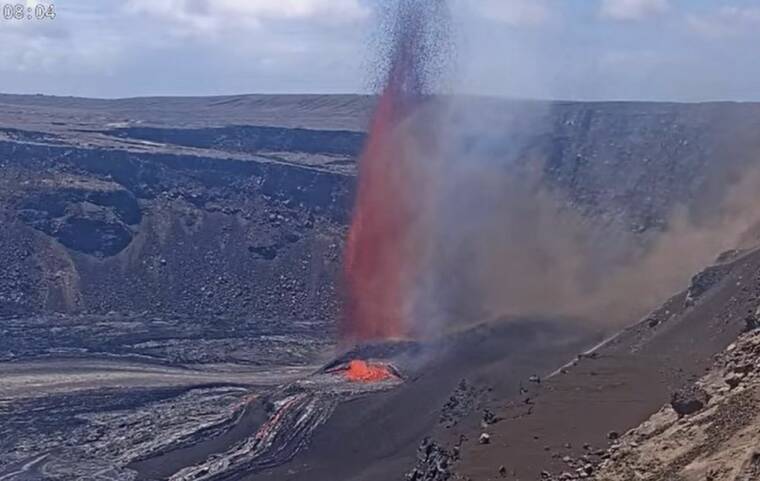Kilauea lava fountains ramp up to over 200 feet in ‘16th episode’


Scientists at the Hawaiian Volcano Observatory said that the high fountain phase of “episode 16” had begun as of 10:24 a.m., about 12 hours after the start of the eruption.
Fountaining from the south vent rapidly increased to over 200 feet high by 10:40 a.m., HVO said, and exceeded 700 feet by 10:50 a.m. HST. Low dome fountaining and overflows, meanwhile, continue from the north vent.
Hawaii County Civil Defense, meanwhile, is warning of tephra falling onto Highway 11, or Hawaii Belt Road, in the Kau District between mile markers 35 and 37.
“If you are in this area, please do not stop, do not get out of your vehicle, and keep your window fully rolled up,” said Civil Defense in an alert. “There are no road closures at this time. However, road closures could occur without notice.”
Scientists at the Hawaiian Volcano Observatory said “episode 16” of the ongoing eruption began at 10:57 p.m. on Monday, with lava overflowing from the north vent.
Weak spattering began at about 5:20 p.m. Monday, which later became continuous and increased to low fountaining, eventually leading to a lava flow out of the north vent onto the floor of Halemaʻumaʻu.
Just before 10 a.m. today, scientists observed dome fountains of 15 to 25 feet and spatter in the north vent, with continued lava flows.
“High fountaining is expected to follow this period of low-level activity, as has occurred in previous episodes,” said HVO scientists with the U.S. Geological Survey.
Each of the prior 15 episodes, HVO noted, ultimately involved significant lava fountaining. The fountains of “episode 15,” which ended at 7:10 p.m. on Friday after just over 31 hours, exceeded 1,000 feet in height.
The current on-again, off-again eruption began Dec. 23 with each episode lasting for between 13 hours to 8 days, separated by pauses in eruptive activity lasting from less than 24 hours to 12 days, according to HVO.
All episodes have been confined to Halemaumau Crater within Kaluapele, the summit caldera of Hawai‘i Volcanoes National Park.
No significant changes have been noted along Kilauea’s East Rift Zone or Southwest Rift Zone.
The Kilauea volcano alert level remains at watch, and the aviation color code remains at orange.
Hazards from the eruption include vog, or volcanic smog, Pele’s hair, and tephra (rock fragments) that can affect the park and nearby communities.
Pele’s hair are thin, golden-brown strands of volcanic glass formed during eruptions when molten lava stretches and cools quickly, according to HVO, and the tiny fibers can get lodged in skin and eyes.
Emissions of sulfur dioxide are elevated, with recent episodes having reached 50,000 tons per day or more, HVO warned, with similar amounts of gas expected to accompany any high fountaining activity during this episode.
A livestream of the Kilauea summit is available at this link.
Vog information is available at vog.ivhhn.org.



